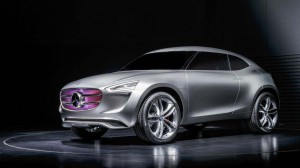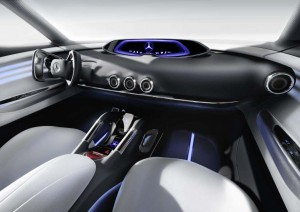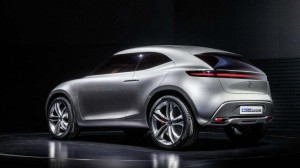
Mercedes newest concept is designed to SUC. Well, it's a sport-utility coupe, or SUC, according to the maker.
When Mercedes-Benz lifted the covers on its G-Code concept in Beijing yesterday, the German maker said it was intentionally designed to SUC.
This new sport-utility coupe (SUC) “study” is the debut work of the new Mercedes-Benz Product Engineering Center in the Chinese capital – one of five such facilities around the world intended to serve as “seismographs,” the maker suggests, for “market-specific developments.” And the G-Code concept offers a hint of the trends the maker sees coming in China.
With its endemic pollution problems, the central government is pushing for zero-emission vehicle technology, but rather than going to a solely battery-electric design, the G-Code uses a combination of hydrogen and electric power – and helps create its own hydrogen by tapping the sun’s energy collected by a unique solar cell paint.
The G-Code goes further. That solar-generated electricity is used to electrolyze – or split – water into its fundamental components, the hydrogen used to help power the vehicle. The oxygen provides “a refreshing effect,” as it is then piped to the SUC concept’s interior to help passengers breathe easier in a place like smoggy Beijing.
Mercedes isn’t the first to create a hydrogen car. Hyundai recently launched sales of its new fuel-cell-powered Tucson, and Honda and Toyota will launch fuel-cell vehicles of their own next year. The G-Code goes a different route, using hydrogen to run what it describes as a “compact, state-of-the-art turbocharged combustion engine” that powers the front axle. The rear axle, in turn, features a small electric motor.
There is an onboard battery that can, among other things, function in hybrid mode, recapturing energy during braking and coasting. But the G-Code also generates energy from its “multi-voltaic” paint, which effectively turns the SUC into a giant solar cell. It also can produce current electrostatically, from air friction as the vehicle is driven.
Squat and muscular, the 2+2 four-seater measures 4.1 meters, or just short of 14 feet nose-to-tail, 1.9 meters in width and 1.5 meters in height.
(Mercedes-AMG teaming with Agusta. For more, Click Here.)
Visually, it bears some similarity to recent Mercedes sport-utility designs, such as the new GLA, but it adds a glowing blue grille – said to create an image of the warp drive system on the Star Trek series’ Starship Enterprise – and 21-inch aluminum wheels with delicate carbon-fiber spokes.

The G-Code Concept is the latest concept from the Mercedes-Benz Product Engineering Center in Beijing.
(Click Here for details about Nissan’s quarterly earnings results.)
To complement the through-the-road all-wheel-drive system, the G-Code has short front and rear overhangs and a high ride height for those with “sporty ambitions both on and off the road.”
Despite the edgy, sci-fi touches, the G-Code isn’t entirely fantasy. BMW has also shown that hydrogen can be used to power an internal combustion engine, while General Motors has toyed with technology to produce hydrogen onboard. And even the multi-voltaic paint technology is actually under development.
(To see why there is big interest in autonomous vehicles in Asia, Click Here.)
Nonetheless, don’t expect to see something as far-reaching as the G-Code concept anytime soon. But a more conventional version of the SUC might be another matter. In China, that is, the maker stressing that the design comes from Asia “for Asia.”


Congrats to Mercedes. They completely achieved a new design that really SUCKS! I hope they didn’t invest more than $20 and five minutes on this FUGLY looking POS because it really, really SUCKS as far as the styling goes – and evidently that was their goal.
MB is stealing ideas from Nissan.